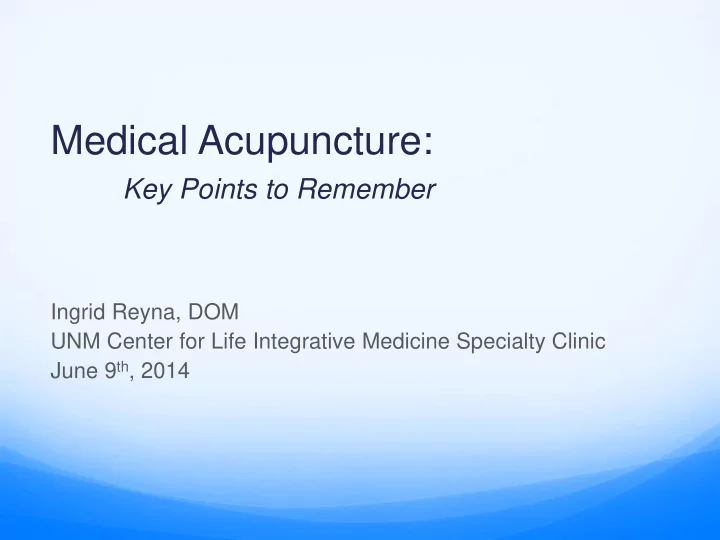

Medical Acupuncture: Key Points to Remember Ingrid Reyna, DOM UNM Center for Life Integrative Medicine Specialty Clinic June 9 th , 2014
Objectives Discuss the basic philosophy of acupuncture and traditional Chinese Medicine Describe the history, proposed mechanism of action, and safety of acupuncture Demonstrate a basic understanding of practice of acupuncture and its current evidence of efficacy.
What is Acupuncture? Technique of insertion and manipulation of fine needles in specific points (acupoints) on the body to achieve therapeutic affect. Practiced widely in China for more than 4000 years and is the pillar of traditional Chinese medicine. Has gained popularity in the United States. According to 2007 National Health Interview Survey, an estimated 3.1 million US adults and 150,000 children had acupuncture in the previous year.
How might acupuncture work? • No single mechanism explanation • The Gate Control Theory • Endorphin Model • Neurotransmitter Model
Gate Control Theory PAIN I = Inhibition Neuron T = Transmission Neuron
6 Direct effect in the up-regulation of opioid receptor binding availability in the central nervous system.
Neurotransmitter Model • Research in animals has found that acupuncture can adjust serotonin, norepinephrine, and neurons that transmit or secrete amino-butyric acid. • Acupuncture can be effective for treatment of depression, anxiety and addiction.
Acupuncture indirectly influences the autonomic system.
What does the evidence show? Nausea & Vomiting Postoperative ielus Headache Back pain
Postoperative nausea and vomiting (PONV) 2009 Cochrane Collaboration review of 40 trials involving 4,858 participants Suggest that use of P6 acupuncture point can reduce the risk of nausea and vomiting after surgery
Postoperative ileus Three RCTs in patients with abdominal surgeries improved GI motility with acupuncture - first bowel sound time - flatus passage time - excretion time - Sun P et al 1996 - Liu XJ et al 1991 - Zhang X et al 1998 Addition of auricular acupuncture also relieved abdominal distension and discomfort after abdominal surgery. - Wan Q et al 2000
Headache 2009 Cochrane Collaboration review of 22 trials involving 4,419 participants Suggest that acupuncture is at least as effective as, or possibly more effective than, prophylactic drug treatment
Back pain Meta-analysis by Manheimer et al. 2005 of 22 RCT Suggest acupuncture is an effective treatment of chronic low back pain.
• Within the past few decades more research is emerging. • 1997 – National Institutes of Health Consensus Conference discussed several medical conditions in which acupuncture is effective or may be useful. • 2003 – WHO identified 28 diseases or conditions for which acupuncture has been proven effective.
Acupuncture Risk Overall Risk 0 – 1.1 per 10,000 Bruising, soreness, bleeding Fainting Pain at insertion site Pneumothorax Infection rate negligible in two large prospective studies of 34,000 and 97,733 patients
Disposable Sterile Stainless steel
17 • Finely tapered surgical sterile stainless steel • Thinner than average human hair
Take Home Points • Scientific evidence for acupuncture continues to expand. • Acupuncture is safe and effective integrative option for your patients.
Recommend
More recommend